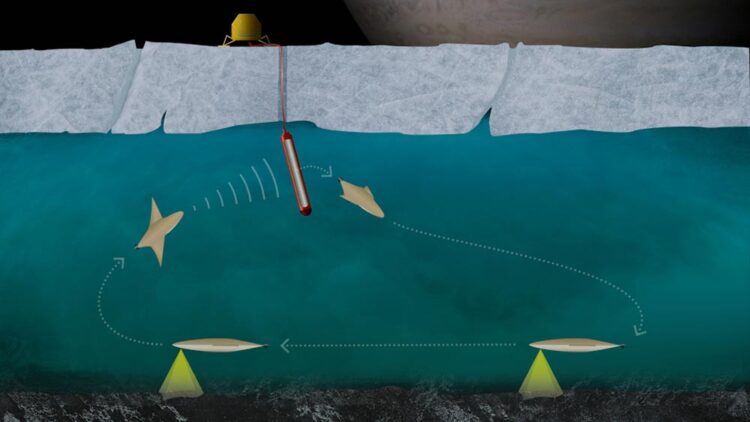New joint project TRIPLE-MoDo

The illustration shows the operation of the station, the ice probe and the small autonomous submersible vehicle. With its help it will be possible to take samples from the ice-covered waters. Graphic: MARUM, Center for Marine Environmental Sciences, University of Bremen
Bremen consortium develops innovative docking system for underwater robots.
How can inaccessible places on the Earth, such as the deep sea, as well as those on other planets be investigated? Extreme goals present extreme challenges for the technology used. These are more serious than just corrosion or resistance to unusual pressures. For example, the new technological solutions will enable communication with and supply of energy to underwater robots by way of an innovative docking system. Toward this end, a consortium of three Bremen partners have initiated the research and development project TRIPLE-MoDo.
Exploration of our world’s oceans as well as extraterrestrial oceans requires robotic systems that can operate independently and for extended periods of time underwater. A Bremen consortium has begun working on an innovative docking system for this purpose as part of the project TRIPLE-MoDo (“Technologies for Rapid Ice Penetration and Subglacial Lake Exploration – Mobile docking”). The project partners include DSI Aerospace Technology GmbH, the Robotics Innovation Center of the German Research Center for Artificial Intelligence, and MARUM – the Center for Marine Environmental Sciences at the University of Bremen. The project is being financed by the Space Administration of the German Aerospace Center in Bonn.
The planned system will allow an autonomous underwater vehicle (AUV) to dock with an underwater station in order to transfer data it has collected and to recharge its batteries, and thus to remain underwater for extended periods of time. In order to overcome the challenging issues encountered with docking in deep waters, the partners are using components from the field of soft robotics. These components are noted for their great flexibility and their ability to gently absorb collisions.
The TRIPLE-MoDo project is one of several initiatives that make up the overarching TRIPLE project line in the DLR’s Space Administration. The mission of the project line is to develop an intelligent exploration system that can be used to carry out scientific activities in waters that lie beneath ice. The projected system consists of a fully autonomous very small submersible vehicle, called a nanoAUV, a partially autonomous melting probe that melts the ice and serves as a transport system for the AUV, and an astrobiological laboratory (AstroBioLab) to analyze liquid and sediment samples. The melting probe also serves as a fixed underwater station for the submersible to transfer data and energy.
This innovative system promises to be of great value for planetary missions as well as for near-Earth space applications. The interest on the part of space research is to eventually utilize this kind of system, when it has been deployed and tested on the Earth, for the exploration of oceans on other planets and bodies, such as Jupiter’s moon Europa. It is speculated that hydrothermal seeps may be present in water depths of 100 kilometers beneath the ice cover of Jupiter’s moon, which, because of the associated heat flow and influx of minerals, could support life even in those dark and cold regions.
“Europa’s presumed ocean contains an amount of water that is equal to about twice that found on planet Earth,” explains the project leader Dr. Christoph Waldmann of MARUM. “The exciting question is whether there are traces of past or present life forms in these extraterrestrial oceans.”
The fully developed system should be completed by 2027 and tested during a demonstration mission to the Antarctic region with close cooperation by marine and space scientists.
Contact:
Dr. Christoph Waldmann
Head Coordinator of TRIPLE-nanoAUV 1
MARUM – Center for Marine Environmental Sciences, University of Bremen
Telephone: +49 421 218 65606
Email: waldmann@marum.de
Dr.-Ing. Jochen Rust
Project Coordinator of TRIPLE-MoDo
DSI Aerospace Technologie GmbH
Telephone: +49 421 596969 35
Email: jochen.rust@dsi-as.de
Dipl.-Ing. Miguel Bande Firvida
Team Leader TRIPLE-nanoAUV
Telephone: +49 421 17845 5064
Email: Miguel.Bande_Firvida@dfki.de
MARUM produces fundamental scientific knowledge about the role of the ocean and the ocean floor in the total Earth system. The dynamics of the ocean and the ocean floor significantly impact the entire Earth system through the interaction of geological, physical, biological and chemical processes. These influence both the climate and the global carbon cycle, and create unique biological systems. MARUM is committed to fundamental and unbiased research in the interests of society and the marine environment, and in accordance with the Sustainable Development Goals of the United Nations. It publishes its quality-assured scientific data and makes it publicly available. MARUM informs the public about new discoveries in the marine environment and provides practical knowledge through its dialogue with society. MARUM cooperates with commercial and industrial partners in accordance with its goal of protecting the marine environment.
https://www.marum.de/en/Discover/New-joint-project-TRIPLE-MoDo.html
More information about the project and the participating partners:
Media Contact
All latest news from the category: Earth Sciences
Earth Sciences (also referred to as Geosciences), which deals with basic issues surrounding our planet, plays a vital role in the area of energy and raw materials supply.
Earth Sciences comprises subjects such as geology, geography, geological informatics, paleontology, mineralogy, petrography, crystallography, geophysics, geodesy, glaciology, cartography, photogrammetry, meteorology and seismology, early-warning systems, earthquake research and polar research.
Newest articles

NASA: Mystery of life’s handedness deepens
The mystery of why life uses molecules with specific orientations has deepened with a NASA-funded discovery that RNA — a key molecule thought to have potentially held the instructions for…

What are the effects of historic lithium mining on water quality?
Study reveals low levels of common contaminants but high levels of other elements in waters associated with an abandoned lithium mine. Lithium ore and mining waste from a historic lithium…

Quantum-inspired design boosts efficiency of heat-to-electricity conversion
Rice engineers take unconventional route to improving thermophotovoltaic systems. Researchers at Rice University have found a new way to improve a key element of thermophotovoltaic (TPV) systems, which convert heat…



